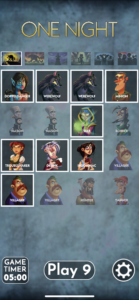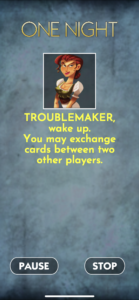For my critical play this week, I played One Night Werewolf with a few of my friends. This game was designed by Ted Alspach and Akihisa Okui for Bezier Games. This game uses both cards/roles provided by the game and an app that serves as the narrator to guide the gameplay. I believe that its target audience is people looking for a fast paced game that involves unilateral gameplay for fans of games like Mafia. It is very easy to learn andis still fun to play with complete strangers. 
The game says that it is for groups of 3-10 players. I played with 9 people this game. After playing, it seems like the more people in the game thebetter because then more roles will be filled and there will be more mystery and hijinx that occurs to add to the fun. The game is completed in one round which includes a “night” in which players are instructed by the narrator to carry out the action of their particular role and a “day” in which the players try to determine who the werewolf(s) is. At the end of the “day” everyone votes on who they think the werewolf is. The game is a competition between the werewolf team and everyone else. The townspeople win if the werewolf is correctly identified, otherwise the werewolves win. All in all, this process takes about 10-15 minutes.
This game is definitely a spin off of Mafia. What makes this game fun and different are the different roles that people can play — such as the troublemaker who switches the roles of two people at random. In this way, the people who started off as a werewolf cannot guarantee that they are still in fact the werewolf. I think this makes it more exciting than regular mafia because it adds to the mystery and creates further drama and conflict within the “daytime” discussion. It also makes it so that there is more information to go off of when having those discussions. For example, in regular mafia it’s just going off of fabricated stories and vibes to figure out who the mafia is, but in this game you can have a seer who can tell you definitively what one person is or isn’t. It also gives the werewolf team more room to lie and argue, making the discussions more exciting.

I had a lot of fun playing this game with my friends. Because the rounds were so short, I was able to play a few rounds and try out different roles. I would definitely play it again. One round in which the werewolf team became a little too powerful was when the doppelganger became a werewolf and so the werewolf team took up about half of the players (4/9). It was a little too easy to corroborate a story amongst the doppelganger, 2 werewolves, and minion, so we were pretty easily fooled as the townspeople.
One thing that I would change to make the game more fun is to add new and different roles, which it seems that this game took advantage of already by coming out with a few different variations of the game beyond the original. Another role I might add if I were to create a new one would be The Sandman: a player that at the beginning of the night taps another player on the shoulder and then that player can’t wake up and do their action during the night.
Another problem that I think needs to be solved is how to get the discussion started. There was the sense in which no one wanted to be the first one to talk and give up any information. Maybe to solve this issue, the person to the right of the person that laid out the cards must speak first (and would change people if multiple rounds are played so that the same person is not always the first that has to divulge information).



